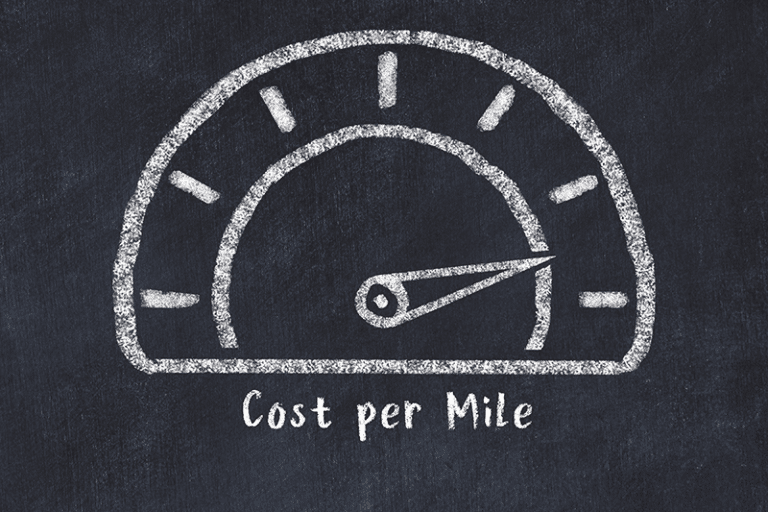The cost per mile is a metric that helps companies determine the expenses associated with trucking services, allowing them to budget effectively and optimize their logistics operations.
Factors Influencing the Cost Per Mile
The cost per mile for trucking services is influenced by many factors: fixed costs, variable costs, and additional expenses. All of which contribute to the overall calculation.
Fixed Costs
Fixed costs are expenses that remain constant regardless of the distance traveled or the amount of cargo being transported.
Some standard fixed costs include:
- Truck payments: Whether a company leases or owns its trucks, regular payments must be made to maintain the fleet.
- Insurance: Trucking companies are required to have insurance coverage for their vehicles, drivers, and cargo. These insurances range from liabilities to physical damage coverage.
- Licensing and permits: Operating a trucking business involves obtaining various licenses and permits with associated fees.
- Depreciation: The value of trucks decreases over time, which should be accounted for in the cost-per-mile calculation.
- Overhead costs: These include costs such as office expenses, salaries for non-driving personnel, and other administrative expenses.
Variable Costs
Variable costs fluctuate based on the distance traveled and the specific demands of each trip.
Some typical variable costs include:
- Fuel: The cost of fuel is a significant expense in the trucking industry, and it is directly impacted by the distance traveled.
- Maintenance and repairs: Trucks require regular maintenance and occasional repairs, with costs increasing as the vehicle ages or accumulates more miles.
- Tires: Tire wear and replacement are directly related to the distance traveled and the type of terrain encountered during transportation.
- Driver wages: Drivers are typically paid based on the distance they travel or their work hours, making their wages variable.
- Tolls and weigh station fees: The use of toll roads and weigh stations may incur additional fees that vary depending on the route taken.
Additional Expenses
In some cases, trucking companies may encounter additional expenses that are not directly tied to fixed or variable costs. These may include:
- Accessorial charges are fees for additional services, such as loading and unloading or specialized equipment needed for specific cargos.
- Detention fees: Detention fees apply when a truck driver reaches a destination and experiences delays while waiting to load or unload their cargo. Typically, carriers offer a specific number of “free hours” for each driver, but once that time allowance has been exceeded, they charge an hourly rate. It’s important to note that drivers earn their wages by transporting and delivering goods rather than waiting for their cargo.
- Layover fees: Layover fees may be incurred if a driver is forced to wait overnight due to scheduling issues.
Calculating the Cost Per Mile
Calculating the cost per mile for trucking is a big step in businesses that must consider all fixed costs, variable costs, and additional expenses.
The formula for calculating the cost per mile is as follows:
Cost Per Mile = (Fixed Costs + Variable Costs + Additional Expenses) / Total Miles Traveled
By breaking down the expenses into these categories and using this formula, businesses can better understand their trucking costs and make informed decisions about their transportation needs.
Strategies to Lower the Cost Per Mile
There are several strategies that businesses can employ to lower their cost per mile for trucking, which can ultimately result in increased profitability and more efficient operations.
These strategies can include:
- Fuel-efficient practices: Encouraging drivers to adopt fuel-efficient driving habits, such as maintaining a consistent speed and minimizing idling, can help reduce fuel costs.
- Regular maintenance: Properly maintaining trucks can help prevent costly breakdowns and extend the life of the vehicles, ultimately lowering overall maintenance expenses.
- Optimizing routes: Utilizing route optimization software or other logistics tools can help businesses identify the most efficient routes for their trucks, reducing fuel consumption and travel time.
- Negotiating with suppliers: Building solid relationships with suppliers, such as fuel providers or tire manufacturers, can lead to bulk discounts or more favorable pricing arrangements.
- Reducing empty miles: Ensuring trucks are loaded with cargo for outbound and inbound trips can help minimize empty miles, making each trip more cost-effective.
- Investing in newer, more efficient trucks: Newer trucks often come with advanced technology and improved fuel efficiency, which can result in lower operating costs over time.
- Retaining and training drivers: Investing in driver retention and training programs can lead to a more skilled workforce, ultimately contributing to improved efficiency and reduced costs.
The Importance of Accurate Cost Per Mile Calculations
Understanding the cost per mile for trucking is essential for businesses to make informed decisions about their transportation and logistics operations.
Accurate cost-per-mile calculations can help businesses:
- Determine the profitability of specific routes or customers: By understanding the actual cost per mile, businesses can identify which routes or customers are more profitable and focus on maximizing their resources in those areas.
- Make data-driven decisions about pricing and contracts: A clear understanding of the cost per mile can help businesses price their services more accurately and negotiate contracts with customers that reflect the service’s true cost.
- Identify areas for cost reduction: By analyzing the various factors contributing to the cost per mile, businesses can identify opportunities for cost savings and implement strategies to improve efficiency.
- Monitor the financial health of the business: Regularly calculating the cost per mile can serve as a key performance indicator for the financial health of a trucking business, allowing owners and managers to track their progress over time.
Summary
Implementing strategies to lower the cost per mile can increase profitability and more efficient transportation processes.
In an industry where margins can be tight, understanding and managing the cost per mile is essential for long-term success.
Canal Cartage Company understands these variables and we do the work for you. Come drive with us today!



